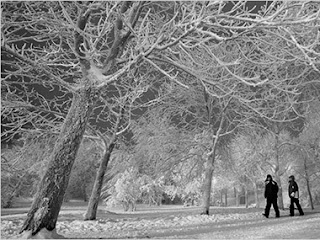Yes, it's time for the weather forecast for the coming winter of 2011-2012, which I would like to remind everyone, is right around the corner! The following post represents paraphrased and copied wording from information I gleaned off reliable sources. It may or may not be accurate in all regards. I like to post these to see, months from now, just how accurate they were.
--------------------------Beginning with trends. Last winter was the coldest in 30 years across many parts of the US. Some eastern parts of the US plunged to a record -50F with the Northeast of the US also seeing many records broken. Temperatures, in general, were below normal for large Midwestern and Eastern cities like New York, Chicago, New Orleans, and Minneapolis. Snowstorms shattered records in New York City in December 2010 and January 2011 to make January the snowiest ever recorded.
So let me turn to the US winter forecast for 2011/2012.
La Niña cooling the equatorial seas of the Pacific and was one of the strongest on record during 2010/2011. (Less warm air rises during La Niña conditions with a cooling influence on the atmosphere that has big implications on global climate and global weather patterns). The changes in global weather patterns originate from air pressure changes in atmospheric cycles known as the North Atlantic Oscillation (NOA) and Arctic Oscillation (AO).
The latest National Oceanic and Atmospheric Administration (NOAA) data suggests neutral conditions ahead, but a negative Pacific Decadal Oscillation (PDO) may yet suggest otherwise. (The PDO is a pattern of Pacific climate variance that recently switched to negative (cold) and will remain that way for the next two to three decades). It is considered likely that La Niña will return more frequently during this time period as a negative PDO results in stronger La Niña (cooling) and weaker El Niño (warming) episodes.
Another fly in the ointment is the current low period of solar activity we find ourselves in. Lower levels of solar output act as a primary driver of atmospheric cycles that influence blocking activity patterns/ridges.
Meteorologists, as they consider all of these factors, are currently leaning towards a particularly harsh winter for many parts of the US during 2011-2012. Large parts of Central and North America will face below average temperatures with above average snowfall throughout this winter Temperatures in many Eastern and Western parts of the US are also continued to be forecast below average with above average snowfall amounts.
The Pacific Northwest region will not escape as the scientists also predict this region will experience a very severe winter, including the Cascades snow pack which is likely to see increased levels due to the negative (cold) phase of the PDO.
--------------------------
The bottom line is most everyone may get some measure of extreme weather this coming winter; so get out there and buy yourself a heavy duty snow shovel, or better yet, book an extended stay in the Bahamas!
Note: For anyone with an interest, here is what I wrote about last winter which was based on the Farmer's Almanac.



